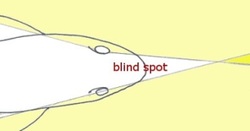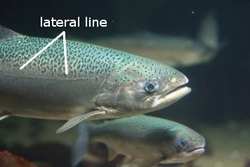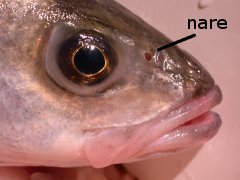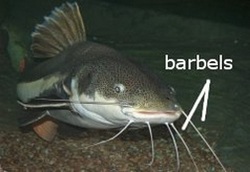
All fishes have senses. They, like you and me, can tell what’s happening around them through their sense of sight, hearing, smell, touch and taste, plus a few others senses we don’t have.
Sight
Fish have very good vision, but their eyes are different than ours. Their lenses are perfectly round, allowing them to see underwater. Freshwater fish have no eye-lids; to regulate the amount of light entering their eyes, they have to actually move to a different depth or area.
Many fish can see in color, which is why lures are manufactured in every color imaginable.
The placement of a fish’s eyes (one on each side of the head) allows fish to see on either side of the fish at same time. The location of the eyes creates a blind spot directly in front of the head, directly behind the fish and straight down.
Sight
Fish have very good vision, but their eyes are different than ours. Their lenses are perfectly round, allowing them to see underwater. Freshwater fish have no eye-lids; to regulate the amount of light entering their eyes, they have to actually move to a different depth or area.
Many fish can see in color, which is why lures are manufactured in every color imaginable.
The placement of a fish’s eyes (one on each side of the head) allows fish to see on either side of the fish at same time. The location of the eyes creates a blind spot directly in front of the head, directly behind the fish and straight down.

Fish can see above the water through a circular “window” in the surface of the water because of the way that light rays bend when they enter the water. If you can see the fish, then most likely it can see you too. Keep a low profile as you near fish-holding water if you want to avoid spooking fish.
Lateral Line
The lateral line is a thin canal that runs along the side of a fish, horizontally, from head to tail on both sides of the fish’s body. The lateral line is crammed with sensory organs that allow the fish to sense temperature changes and “hear” vibrations in the water. Even in murky or dark water, fish can determine the location, speed and size of objects through their lateral line.
Lateral Line
The lateral line is a thin canal that runs along the side of a fish, horizontally, from head to tail on both sides of the fish’s body. The lateral line is crammed with sensory organs that allow the fish to sense temperature changes and “hear” vibrations in the water. Even in murky or dark water, fish can determine the location, speed and size of objects through their lateral line.

Smell
Fish can smell through nostrils called “nares” located on the snout of the fish. Odors in the water help fish locate prey, predators, and even water from far away places (like the water they were born in even when they’re hundreds of miles away.) Though they have a great sense of smell, most fish do not rely on their sense of smell to feed because what a fish can smell at any particular time depends largely on the strength and direction of the current.
Fish can smell through nostrils called “nares” located on the snout of the fish. Odors in the water help fish locate prey, predators, and even water from far away places (like the water they were born in even when they’re hundreds of miles away.) Though they have a great sense of smell, most fish do not rely on their sense of smell to feed because what a fish can smell at any particular time depends largely on the strength and direction of the current.

Taste
While fish can taste through taste buds in their mouth (and sometimes taste buds along the head and side of the body), the sense of taste doesn’t seem to be very important to most freshwater gamefish. Catfish are the big exception to this rule, as they find their food primarily through their acute sense of smell an taste. Catfish can taste through their skin and through their whiskers (called “barbels.”)
While fish can taste through taste buds in their mouth (and sometimes taste buds along the head and side of the body), the sense of taste doesn’t seem to be very important to most freshwater gamefish. Catfish are the big exception to this rule, as they find their food primarily through their acute sense of smell an taste. Catfish can taste through their skin and through their whiskers (called “barbels.”)
How Understanding Fish Senses Can Increase Your Fishing Success
The more you understand fish in general, and your target fish in the specific, the better your chances of catching fish will be. For instance, if you know that catfish find food through their sense of smell, then you’ll want to make sure you have some stinky bait. Here are some general tips relating to fish senses that should help to put more fish on your hook:
The more you understand fish in general, and your target fish in the specific, the better your chances of catching fish will be. For instance, if you know that catfish find food through their sense of smell, then you’ll want to make sure you have some stinky bait. Here are some general tips relating to fish senses that should help to put more fish on your hook:
- Make as little disturbance as possible when you approaching fishable water.
- Don’t run, stomp, or bang your tackle box on the floor of the boat, or even the shore.
- Keep you profile low to avoid being seen by fish in shallow water; you may want to kneel, or even crawl up to a shallow or small stream that’s holding fish.
- Watch your shadow. If you can, keep your shadow off the water, it’s likely to spook fish.
- Try to appeal to fish through more than one sense. Bass lures for instance often use color, sound and vibration to provoke strikes.

 RSS Feed
RSS Feed
